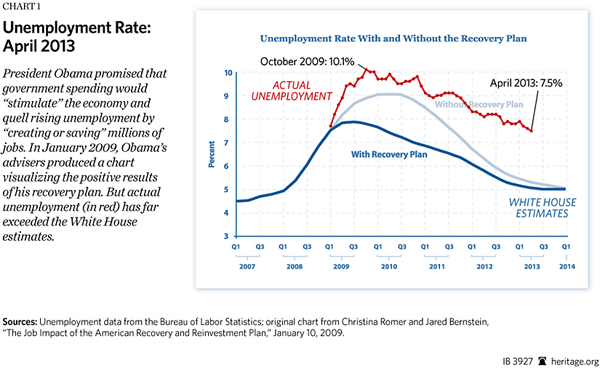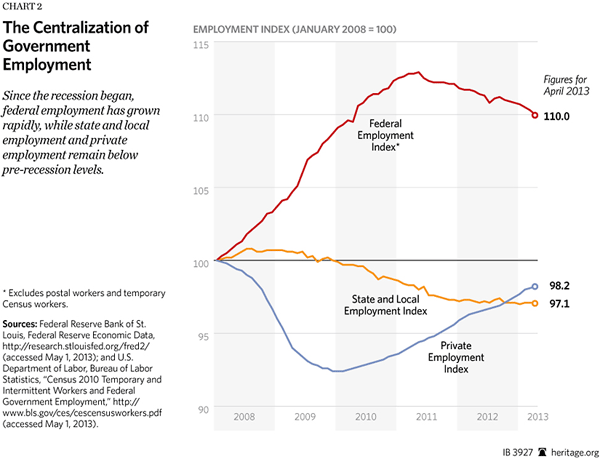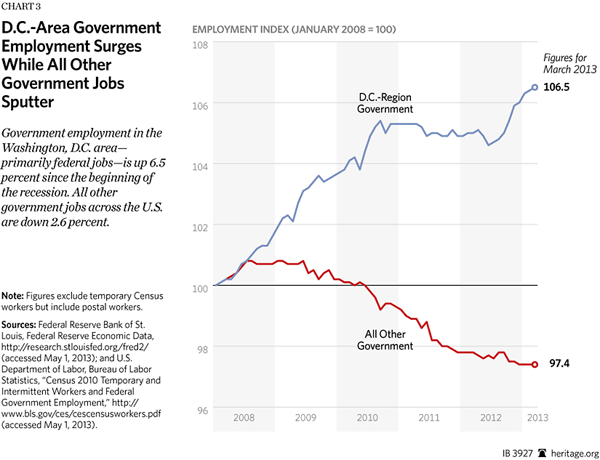The Bureau of Labor Statistics’ April employment report found healthy growth in the labor market in April. Employers added 165,000 net jobs, and the unemployment rate fell slightly to 7.5 percent. While falling short of expectations for a recovery from a deep recession, this would be considered decent growth in normal economic times. However, the improvement in unemployment over the past year and a half comes predominantly from people leaving the labor force.
Moreover, as expected the budget-cutting sequester has had few adverse economic effects. Since sequestration took effect March 1 the labor market has continued to expand while federal employment has fallen by less than half a percentage point.
April Employment Report
The April employment report showed modest but positive economic progress across the board. The household survey reported unemployment falling 0.1 percentage points to 7.5 percent, the lowest since late 2008 and down a full percentage point from December 2011. This drop came primarily from a decrease in the number of the long-term unemployed (–258,000). Unlike in the March report, this drop occurred because employment grew, not because workers dropped out of the labor force. Consequently, the employment-to-population ratio also increased 0.1 percentage points to 58.6 percent.
However, the economy remains weak. While higher than in March, the April employment-to-population ratio is no higher than it was in December 2011. The entire net improvement in unemployment over the past year and a half comes from workers leaving the labor force. Job growth has only sufficed to keep pace with population growth. In 2009, the Obama Administration promised that the huge increase in government spending from stimulus would lead to recovery and low unemployment within a few years. Instead, employment remains persistently low four years later.
In other developments, the number of part-time jobs grew sharply, but this probably reflects statistical noise. Part-time employment fell in March, and the recent increase only returns the figures to February levels.
The payroll survey paints a similar picture of good but modest growth. Employers added 165,000 jobs, with the largest gains coming in professional and business services (+73,000). About two-fifths of those gains came in temporary help services (+30,800), which often acts as a leading indicator of labor market demand. Employment also expanded in retail trade (+29,000), food services and drinking places (+38,000), and health care (+19,000).
Employment in other sectors was mostly flat, with little change in construction, manufacturing, transportation, information, or financial activities. The best news came in the revisions, with employers creating more jobs (+114,000) than previously estimated in February and March.
The Government Sector
The main trends in the job market the past three years have been the slow growth of employment and the steady exodus of frustrated job seekers from the labor force. Another feature of the market has been a mild decline in civilian government employment since it peaked in 2009.[1] There are now about 3 percent fewer jobs in government than there were in 2009, but the decline has been uneven.
State and local governments avoided the massive job losses of 2008 and 2009 that affected the private sector—these governments even grew slightly during the recession. But they have been gradually downsizing ever since. The federal government, by contrast, has expanded rapidly since the recession began. Federal employment, excluding the U.S. Postal Service,[2] peaked in 2011 at 13 percent above 2008 levels. At the same time, the private sector was still mired in the slow recovery, 5.5 percent below 2008 levels. Since 2011, federal expansion has stopped, and a fifth of the recession-era expansion has been reversed.
However, most of the federal employment expansion that took place from 2008 to 2011 remains in place. Despite protestations that the additional employment associated with the stimulus would be temporary, federal employment remains as high as it was three years ago and 10 percent higher than it was before the recession. By contrast, private, state, and local employment are 2 percent to 3 percent below pre-recession levels.
Thus, the main story of government employment in the past five years is that, while it is not uniformly growing or shrinking, it is centralizing. The expansion of the federal government has ultimately come to some degree at the expense of states and localities. As the federal government seeks to command more of the economy—most notably the health care sector—this troubling trend is likely to continue to move employment and power to the least transparent and accountable level of government.
A major economic function of the federal government today is regulating the economy, and the number of regulators has grown by about 50,000 from pre-recession levels.[3] Although regulation only accounts for about one-eighth of the federal workforce, a quarter of all new federal jobs since 2008 are in regulation. Put another way, the regulatory arm of the federal government is growing twice as fast as the rest of the federal government.[4]
The centralization of government can be seen clearly in the fact that Washington, D.C., has been a boomtown through the troubled times. Government employment in Washington is up 6.5 percent since the beginning of the recession, while it is down 2.6 percent in the rest of the country.
The good news is that the expansion of federal employment has been arrested for the past two years. Budget sequestration, which took effect in March, should continue to prevent further growth in government employment during 2013.
Government employment fell by 11,000 jobs in April after a 16,000-job drop in March. These are very modest declines. Despite the budget sequestration, which took effect March 1, non-postal federal job losses over the past two months amounted to just one half of 1 percent of the federal workforce. The Postal Service, which continues to lose money, lost 5,000 jobs, accounting for almost half the drop in government jobs.
Steady but Slow
Today’s jobs report underscores that the economy continues to grow steadily but all too slowly, with no signs yet of the kind of acceleration needed to restore full employment. The report also underscores some developments within the economy, notably that the federal government should continue to diminish, returning more governing functions to state and local governments and allowing the private sector to flourish with less regulation.
—James Sherk is Senior Policy Analyst in Labor Economics and Salim Furth, PhD, is Senior Policy Analyst in Macroeconomics in the Center for Data Analysis at The Heritage Foundation.




